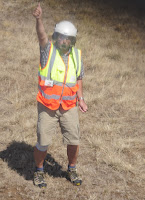Are there enough holes in the Stratocumulus?
 |
| Container ship produces clouds (photo: Matthias Gottschalk) |
Yes, there are. Hence, we can fly after two days of Stratocumulus
(Sc) without any hole to fly though. It was overcast in the morning, but as G1
was already flying, we anyways could not take off earlier. The lunch break of
the airport staff, the helicopter took off at 14:08.
We wanted to capture the Sc
to the north of Graciosa. Below the Stratocumulus layer at roughly 1200 m were
some Cumulus clouds and above some Cirrus and a Contrail. First we flew at 1000
ft above the water and ascended to 6500 ft. Afterwards we kept the height and
went above the stratocumulus layer. We turned west and placed ACTOS within and
SMART-HELIOS above the cloud. With this combination we flew two legs along the
coast of Graciosa. On the third leg we did some a dolphin flight.
 |
| HELIOS&ACTOS below (photo: Matthias Gottschalk) |
We observed
more particles above the inversion and some spikes as we entered the clouds,
while the liquid water content in the clouds peaked at 0.35 g /m³. Afterwards,
we heard Dieter’s voice announcing low level clouds moving in below our cloud
layer. Hence, we turned around, searched for a cloud hole and the pilots
brought everything back safely. Due to major problems HaloHolo is already on
his way back to Mainz and the broadband sensors of SMART-HELIOS failed after 20
minutes. Most of the other instruments recorded well and we hope to have a bit
thicker Sc for our one or two flights tomorrow.
 |
| Mount Pico with Sao Jorge in front (photo: Matthias Gottschalk) |
 |
| André leaves the field for the last time (photo: Matthias Gottschalk) |



Kommentare
Kommentar veröffentlichen